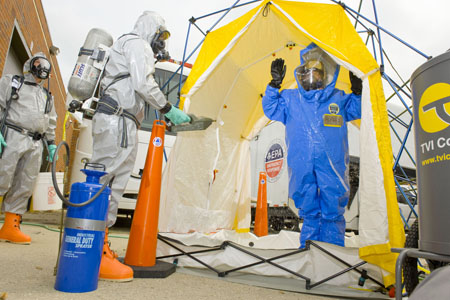The Cleanup Job
By Michaela Burns
EPA helps communities prepare and recover from all sorts of disasters. This includes helping communities prepare for and recover from terrorism. Part of that recovery process involves making contaminated indoor and outdoor facilities like houses and public buildings safe for reuse.
EPA scientists have recently published research investigating the cleanup of blister agents, which are chemical compounds that can cause severe irritation and pain in eyes and on skin. The three blister agents studied, sulfur mustard (neat HD), Lewisite (neat L) and Agent Yellow (HL), a mix of sulfur mustard and Lewisite, are chemical warfare agents that are ranked high for potential terrorist use because they can be easily obtained and can have devastating health impacts.
EPA researchers evaluated how effectively certain decontaminants could remove these blister agents from materials used in public structures like wood, metal and glass. The decontaminants used in this effort include, regular bleach, hydrogen peroxide, dilute bleach and EasyDECON®DF200 (DF200), an oxygen-based decontaminant developed by Sandia National Laboratory. Regular bleach and hydrogen peroxide are of particular interest to researchers because they are substances that are universally accessible and potentially decent decontaminants.
Study results demonstrate that the cleanup process depends on a variety of factors such as the type of blister agent being targeted, the material impacted by the blister agent and the type and strength of the decontaminant method. Researchers were able to eliminate neat L from most surfaces using all four decontaminants. This was not the case with neat HD, where regular bleach proved to be far more effective than the other decontaminants, particularly DF200, on all surfaces except for wood. The last blister agent tested was HL. Decontaminants that were effective against the parent blister agents (neat HD and neat L) were also effective against HD mixed with L (HL) samples and neat L mixed with HD (HL) samples.
These research findings could be crucial to future decisions made about decontaminating contaminated facilities and it is just one of the ways that EPA is protecting our future. Check out the study in the Journal of Hazardous Materials.
About the Author: Michaela Burns is an Oak Ridge Associated Universities contractor and writer for the science communication team in EPA’s Office of Research and Development.



